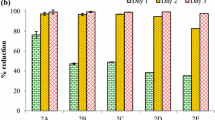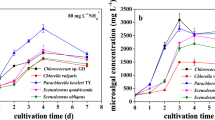Abstract
Phosphate depletion is one of the favorable ways to enhance the sewage water treatment with the algae, however, detailed information is essential with respect to internal phosphate concentration and physiology of the algae. The growth rate of the phosphate-starved Scenedesmus cells was reduced drastically after 48 h. Indicating cells entered in the stationary phase of the growth cycle. Fourier Transform Infrared analysis of phosphate-starved Scenedesmus cells showed the reduction in internal phosphate concentration and an increase in carbohydrate/phosphate and carbohydrate/lipid ratio. The phosphate-starved Scenedesmus cells, with an initial cell density of, 1 × 106 cells mL−1 shows 87% phosphate and 100 % nitrogen removal in 24 h. The normal Scenedesmus cells need approximately 48 h to trim down the nutrients from wastewater up to this extent. Other microalgae, Ankistrodesmus, growth pattern was not affected due to phosphate starvation. The cells of Ankistrodesmus was able to reduce 71% phosphate and 73% nitrogen within 24 h, with an initial cell density of, 1 × 106 cells mL−1.







Similar content being viewed by others
References
de-Bashan LE, Bashan Y (2004) Recent advances in removing phosphorous from wastewater and its future use as fertilizer (1997–2003). Water Res 38:4222–4246. doi:10.1016/j.waters.2004.07.014
Powell N, Shilton AN, Pratt S et al (2008) Factors influencing luxury uptake of phosphate by microalgae in waste stabilization pond. Environ Sci Technol 42:5958–5962. doi:10.1021/es703118s
Woertz I, Feffer A, Lundquist T et al (2009) Algae grown on dairy and municipal wastewater for simultaneous nutrient removal and lipid production for biofuel feedstock. J Environ Eng 135:1115–1122. doi:10.1061/9ASCE0EE.1943-7870.0000129
Xin L, Hong-Ying H, Ke G et al (2010) Effect of different nitrogen and phosphorus concentrations on the growth, nutrient uptake, and lipid accumulation of fresh water microalga Scenedesmus sp. Bioresour Technol 101:5494–5600. doi:10.1016/j.biortech.2010.02.016
Olguin E (2012) Dual purpose microalgae–bacteria-based systems that treat wastewater and produce biodiesel and chemical products within a Biorefinery. Biotech Adv 30:1031–1046. doi:10.1016/j.biotechadv.2012.05.001
Wang C, Yu X, Lv H et al (2013) Nitrogen and phosphorus removal from municipal wastewater by the green alga Chlorella sp. J Environ Biol 34:421–425
Lau SP, Tam FYN, Wong SY (1995) Effect of algal density on nutrient removal from primary settled wastewater. Environ Pollut 89:59–66. doi:10.1016/0269-7491(94)00044-E
Hernandez JP, de-Bashan LE, Bashan Y (2006) Starvation enhances phosphorus removal from wastewater by microalga Chlorella spp. co-immobilized with Azospirillum brasilense. Enzyme Microb Technol 38:190–198. doi:10.1016/j.enzmictec.2005.06.005
Zhang E, Wang B, Wang Q et al (2008) Ammonia–nitrogen and orthophosphate removal by immobilized Scenedesmus sp. isolated from municipal wastewater for potential use in tertiary treatment. Bioresour Technol 99:3787–3793. doi:10.1016/j.biortech.2007.07.011
Mallick N (2002) Biotechnological potential of immobilized algae for wastewater N, P and metal removal: a review. BioMetals 15:377–390. doi:10.1023/A:1020238520948
Ruiz-Marin A, Mendoza- Espinosa LG, Stephenson T (2010) Growth and nutrient removal in free and immobilized green algae in batch and semi continuous culture treating real wastewater. Bioresour Technol 101:58–64. doi:10.1016/j.biortech.2009.02.076
Eixler S, Karsten U, Seling U (2006) Phosphorus storage in Chlorellavulgaris (Trebouxiphyceae, Chlorophyta) cells and it’s dependence on phosphate supply. Phycologia 45:53–60. doi:10.2216/04-79.1
Prieto B, Pardo MA, Garbisu C et al (1997) Phosphate uptake by phosphate starved cells of cyanobacterium Phormidium laminosum. World J Microbiol Biotechnol 13:699–705. doi:10.1023/A:1018583224294
Yao B, Xi B, Hu C et al (2011) A model and experimental study of phosphate uptake kinetics in algae considering surface adsorption and P-stress. J Environ Sci 23:189–198. doi:10.1016/S1001-0742(10)60392-0
Zhang E, Wang B, Ning S et al (2012) Ammonia–nitrogen and orthophosphate removal by immobilized Chlorella sp. isolated from municipal wastewater for potential use in tertiary treatment. Afr J Biotechnol 11:6529–6534. doi:10.5897/AJB11.4281
Jebsen C, Norici A, Wagner H et al (2012) FTIR spectra of algal species can be used as physiological fingerprints to assess their actual growth potential. Physiol Plant 146:427–438. doi:10.1111/j.1399-3054.2012.01636.x
Duygu D, Udoh UA, Ozer T et al (2012) Flourier transform infrared (FTIR) spectroscopy for identification of Chlorella vulgaris Beijerinck 1890 and Scenedesmus obliquus (Turpin) Kützing 1833. Afr J Biotechnol 11:3817–3824. doi:10.5897/AJB11.1863
D’Souza L, Devi P, DivyaShridhar MP et al (2008) Use of Fourier transform Infrared (FTIR) spectroscopy to study cadmium induced changes in Padina tetrastromatica (Hauck). Anal Chem Insights 3:135–143
Beardall J, Breman T, Heraud P et al (2001) A comparison of methods for detection of phosphate limitation in microalgae. Aquat Sci 63:107–121. doi:10.1007/PL00001342
Devi MP, Subhash GV, Mohan SV (2012) Heterotrophic cultivation of mixed microalgae for lipid accumulation and wastewater treatment during sequential growth and starvation phases: effect of nutrient supplementation. Renew Energ 43:276–283. doi:10.1016/j.renene.2011.11.021
Singh G, Thomas PB (2012) Nutrient removal from membrane bioreactor permeate using microalgae and in a microalgae membrane photoreactor. BioresourTechnol 117:80–85. doi:10.1016/j.biortech.2012.03.125
Clescir LS, Greenberg AE, Eaton AD (1999) Standard methods for the examination of water and wastewater, 20th edn. Americal Public Health Asscoiation, American Water Work Association, Water Environment Federation (APHA, AWWA, and WEF). Washington, DC, USA
Maher W, Krikowa F, Louie HW et al (2002) Determination of total phosphorus and nitrogen in turbid wasters by oxidation with alkaline potassium peroxodisulfate and low pressure microwave digestion, autoclave heating or the use of closed vessels in a hot water bath: comparison with Kjeldahl digestion. Anal Chem Acta 463:283–293. doi:10.1016/S0003-2670(02)00346-X
Stehfest K, Toepel J, Wilhelm C (2005) The application of micro-FTIR spectroscopy to analyze nutrient stress related changes in biomass composition of phytoplankton algae. Plant Physiol Biochem 43:717–726. doi:10.1016/j.plaphy.2005.07.001
Ponnuswamy I, Madhavan S, Shabudeen S (2013) Isolation and characterization of green microalgae for carbon sequestration, waste water treatment and bio fuel production. Int J Biosci Biotechnol 5:17–26
Acknowledgments
Authors gratefully acknowledged CSIR, Government of India for funding for this work.
Funding
Financial support from CSIR, Government of India under project “Clean Water: Recovery of water from domestic wastewater using membrane-based systems Project code# ESC0306”.
Author information
Authors and Affiliations
Corresponding author
Ethics declarations
Conflict of interest
No potential conflicts of interest was reported by the author(s).
Rights and permissions
About this article
Cite this article
Yewalkar-Kulkarni, S., Gera, G., Nene, S. et al. Exploiting Phosphate-Starved cells of Scenedesmus sp. for the Treatment of Raw Sewage. Indian J Microbiol 57, 241–249 (2017). https://doi.org/10.1007/s12088-016-0626-0
Received:
Accepted:
Published:
Issue Date:
DOI: https://doi.org/10.1007/s12088-016-0626-0




